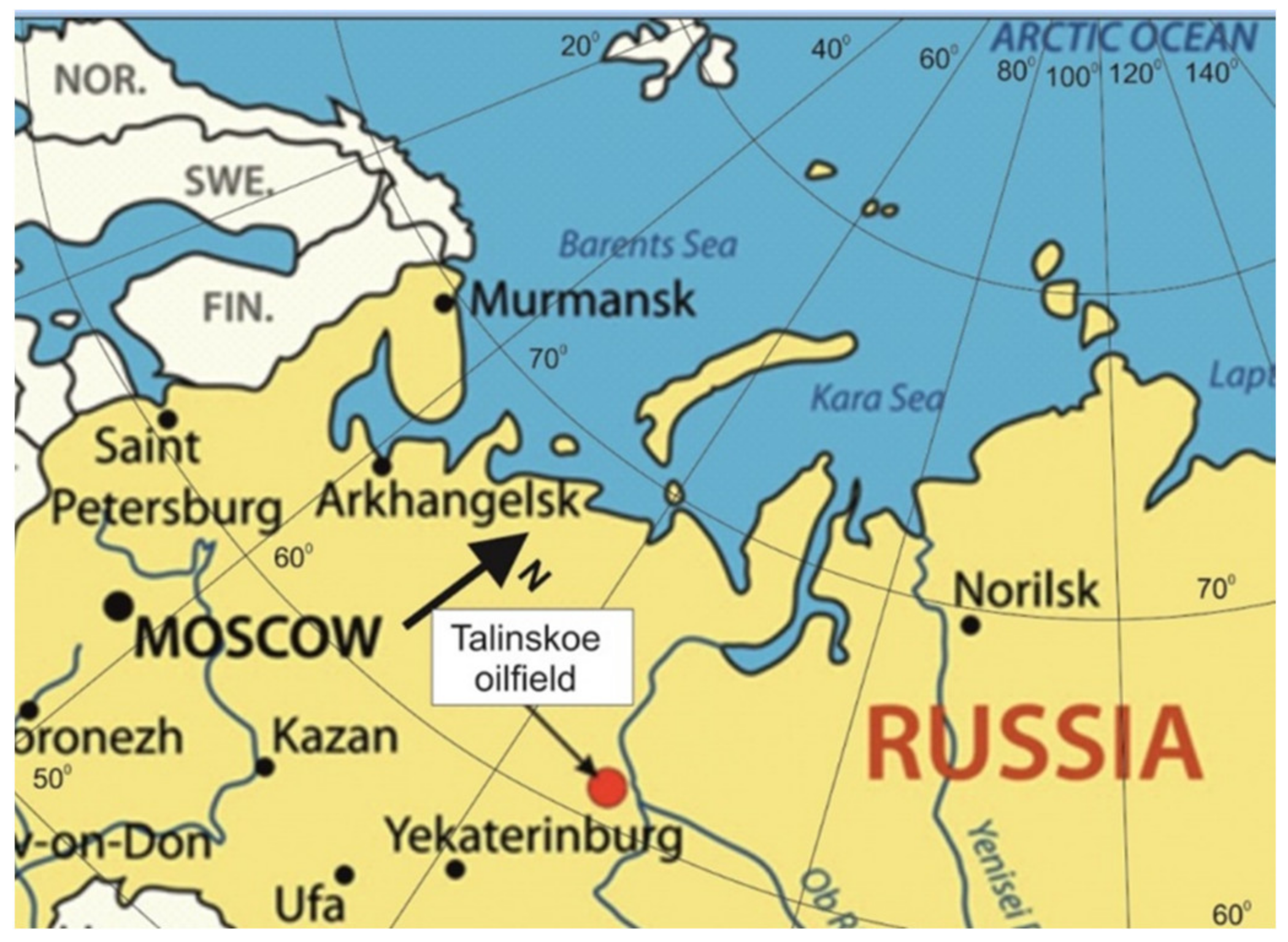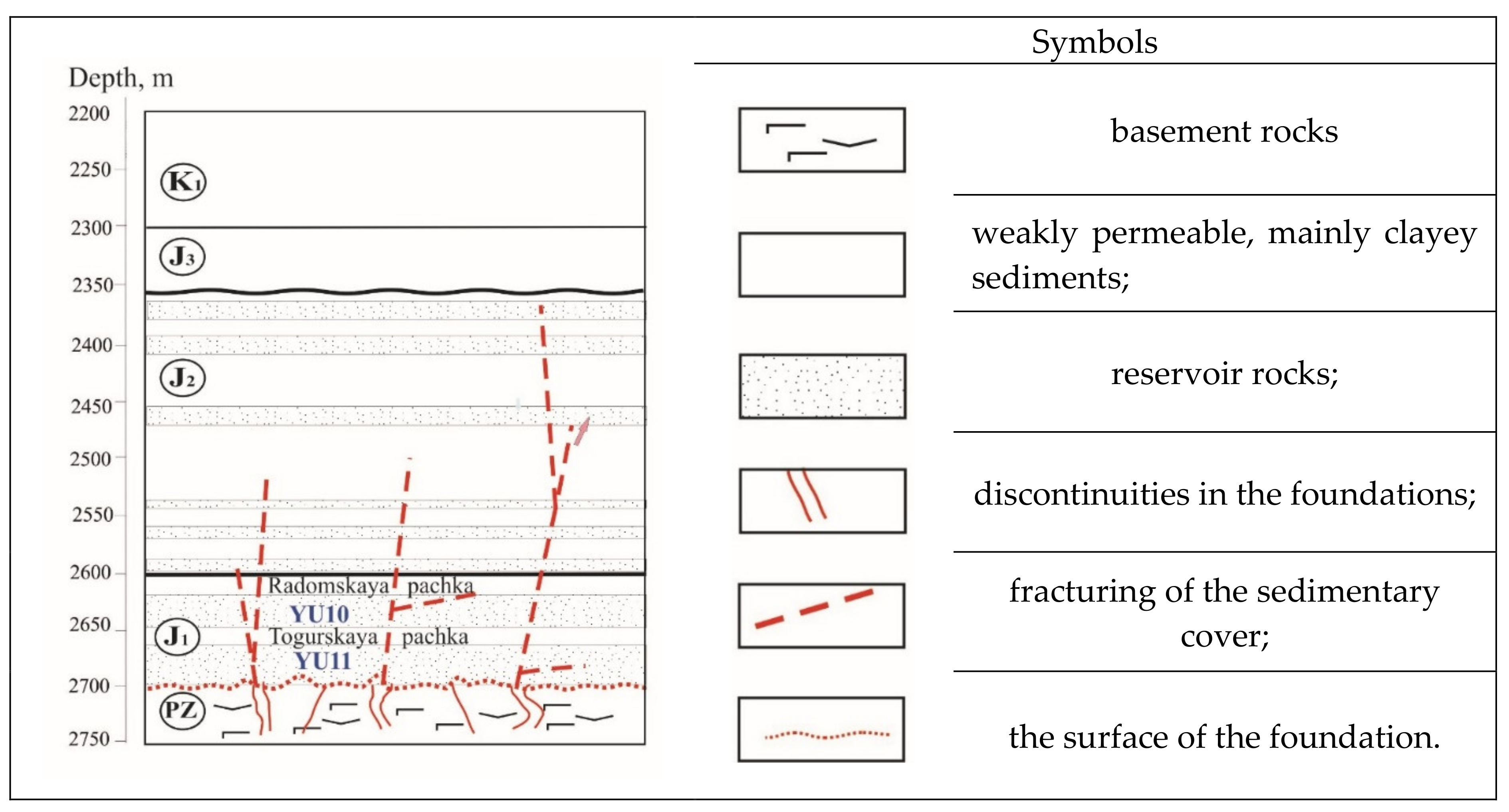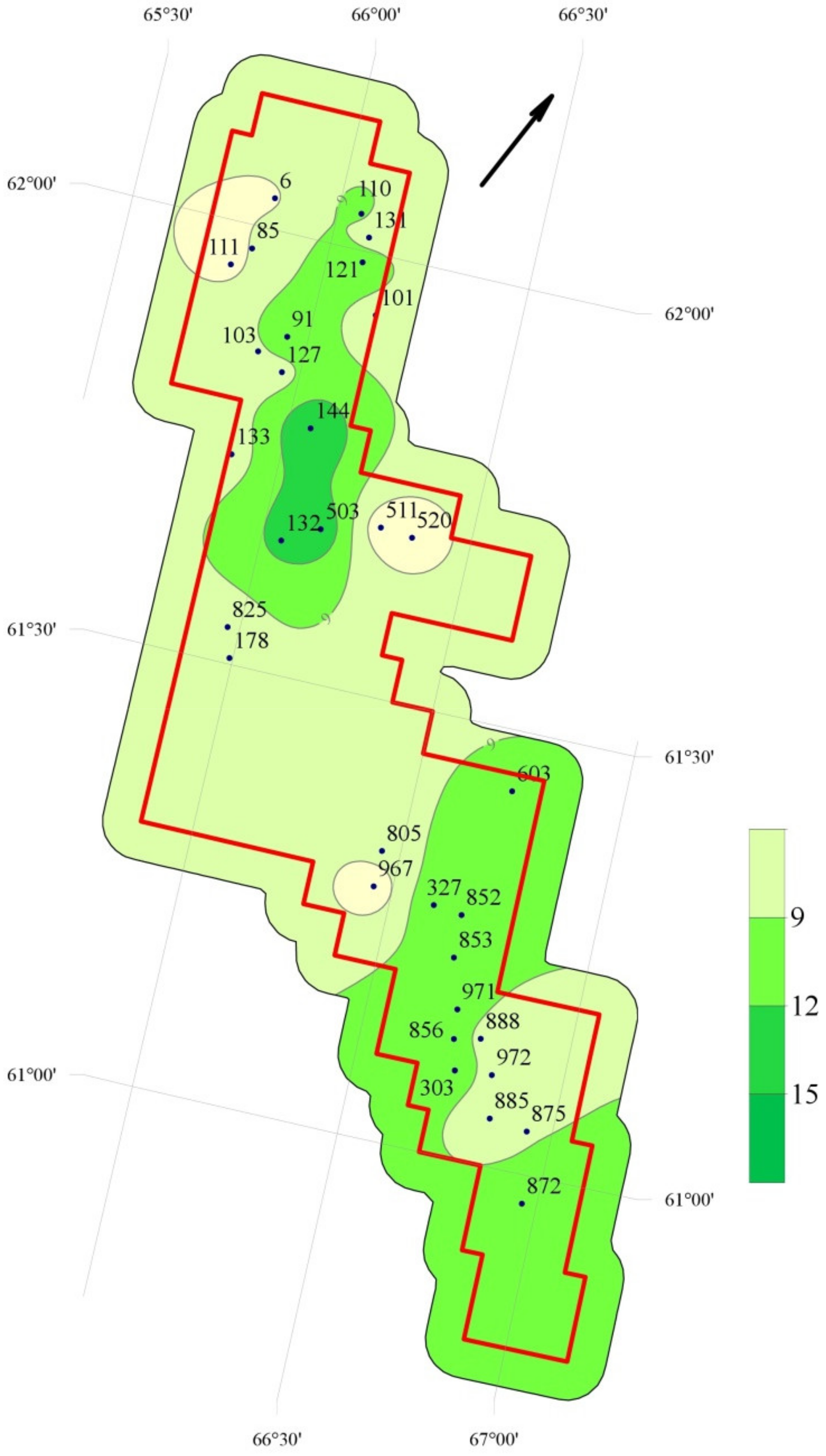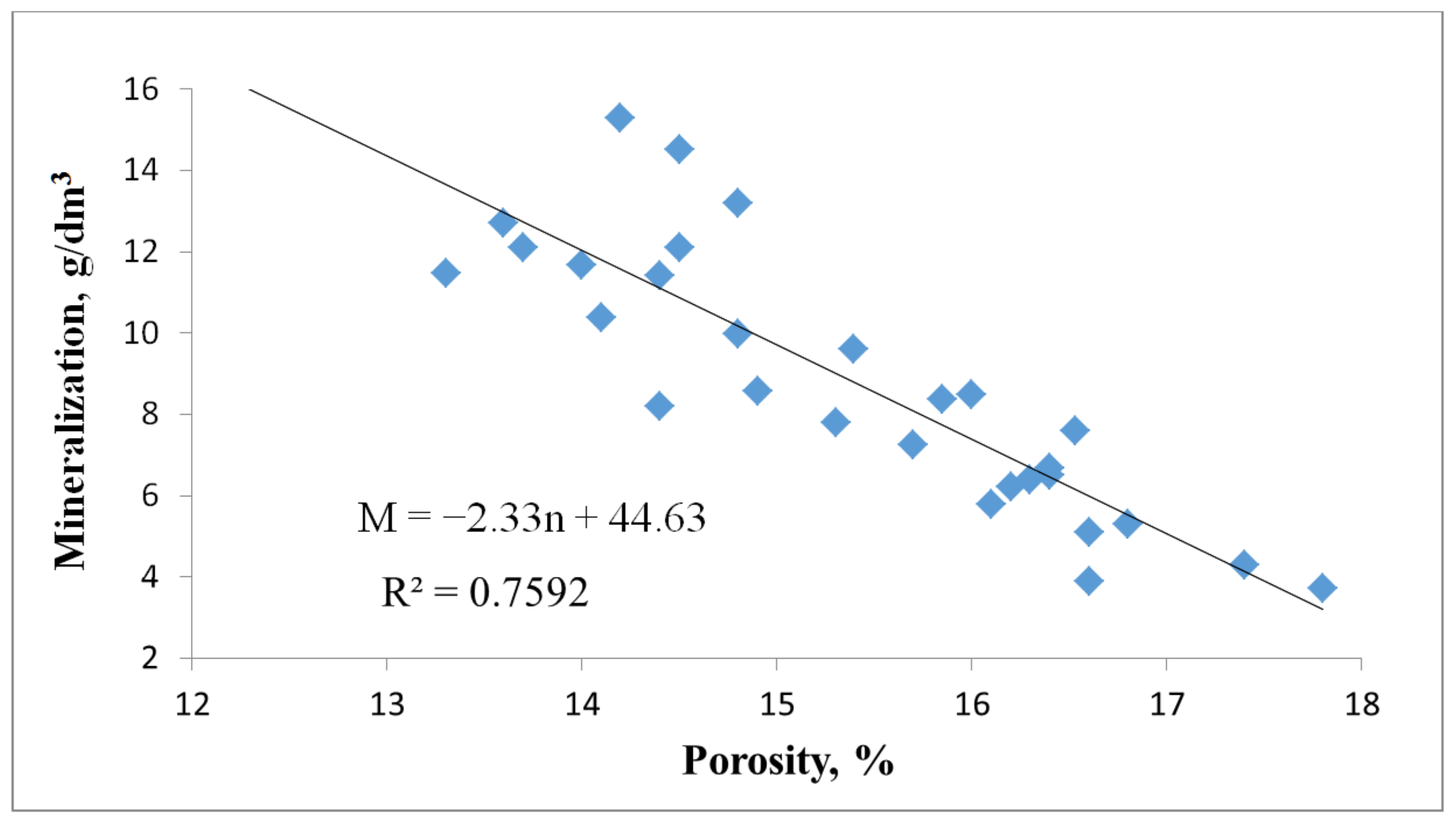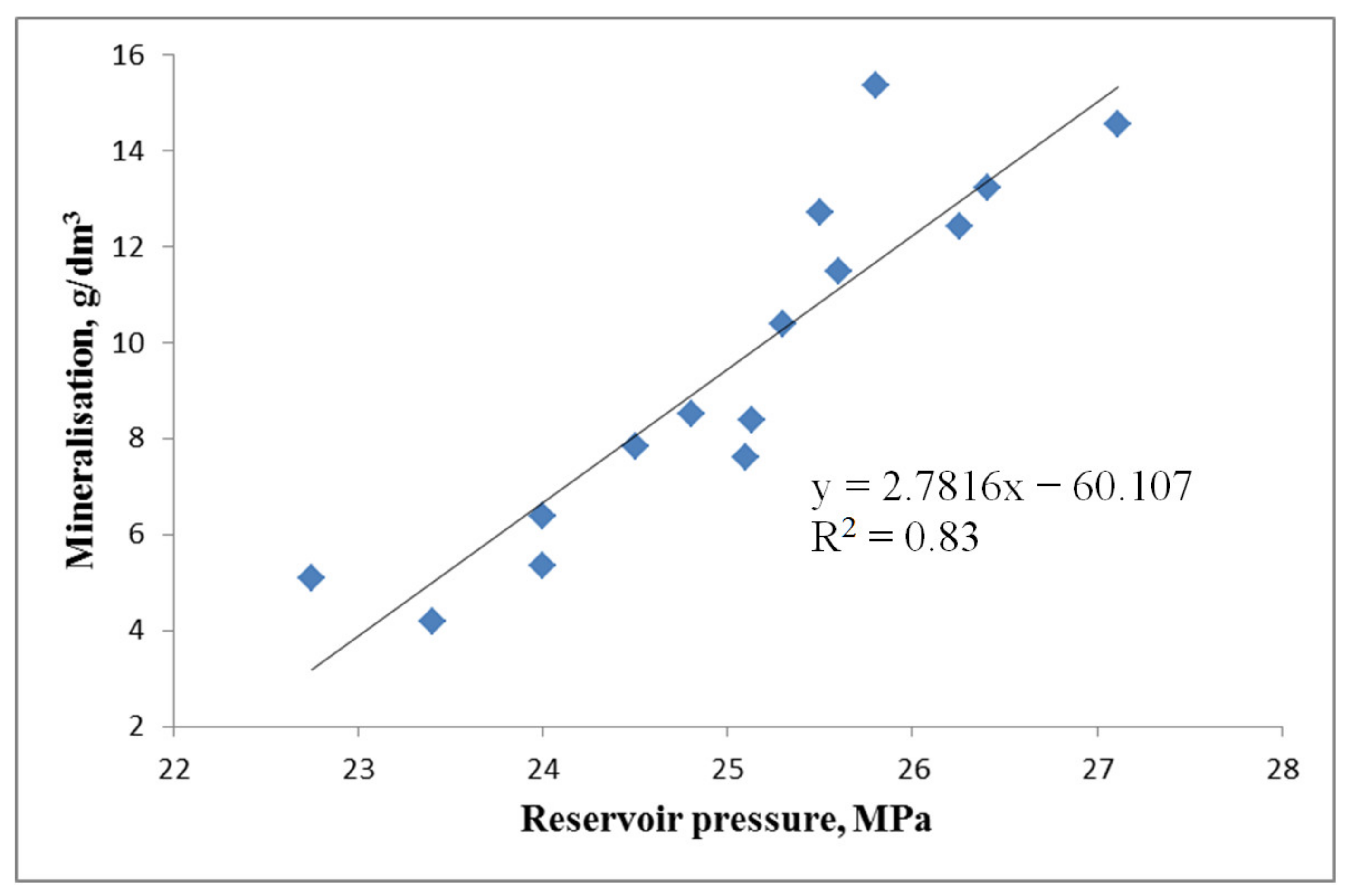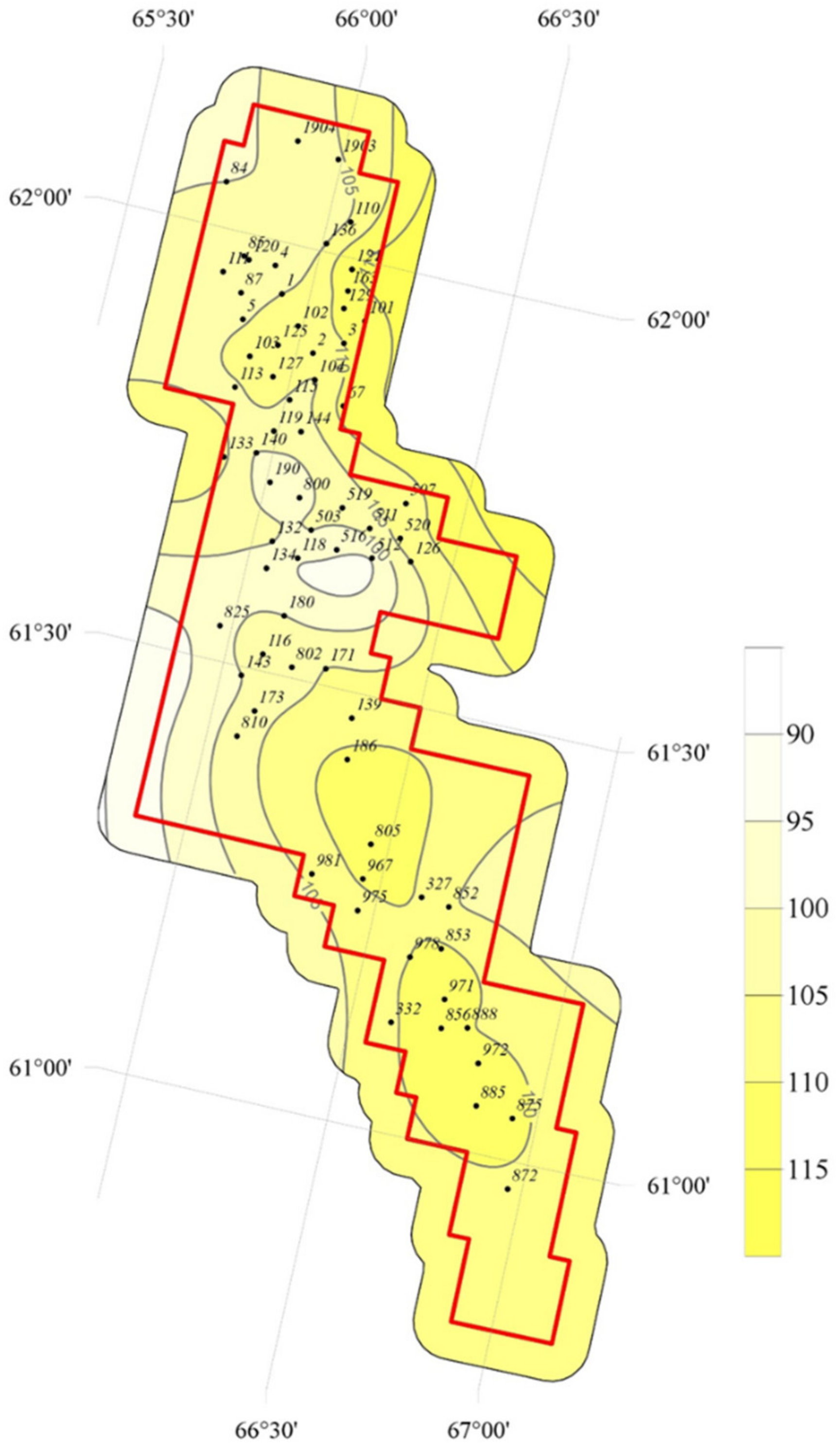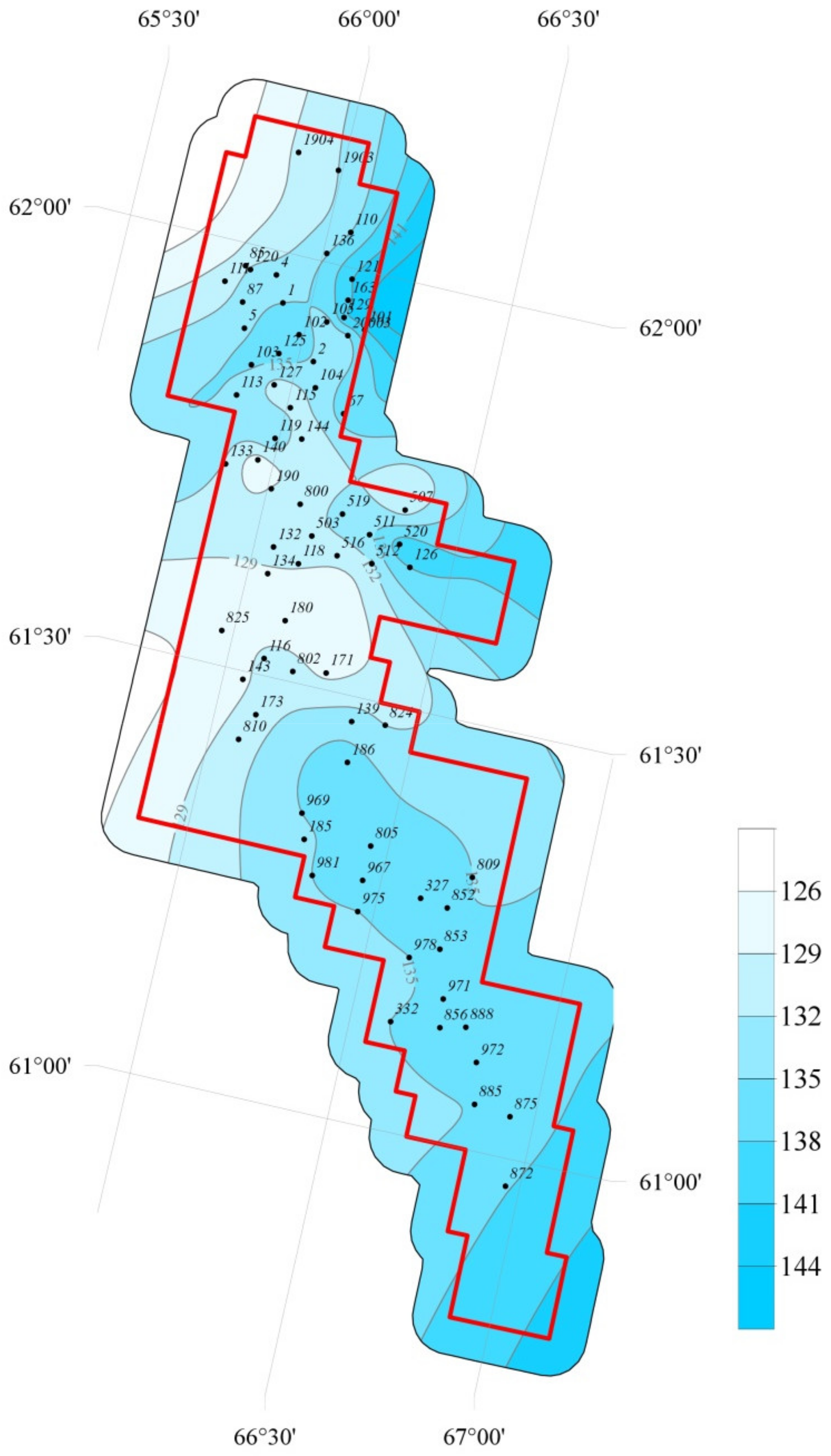5.1. Revealing the Likeness of the Compositions of Various Genetic Types of Waters
The calculation results of the coefficients for reservoir waters (with salinity below and above 7 g/dm
3), pore waters, Paleozoic waters, and injected waters are given in
Table 8.
The Lower Jurassic reservoir waters with a reduced salinity (5.17 g/dm3) are presumably closest in the ionic salt composition to the pore waters. The composition has equal portions of 76% eq. chloride ions and 95% eq. sodium and potassium ions. The rCa/rNa coefficient values coincide, 0.03. In that case, the difference in the rCa+rMg/rHCO3 is significant and is two times as low for the pore waters (1.02) as for the reservoir waters (0.41). In the same manner, the rCl/rHCO3 coefficients differ by 2.6 times (3.7 for reservoir waters with reduced salinity and 9.5 for pore waters). Presumably, the pore waters that have been widespread within the survey region due to the development of the water drive system exerted a significant effect on the genesis of the ionic salt composition of the reduced-salinity reservoir waters of the Lower Jurassic complex.
The ratio of ions in the reservoir waters of the Lower Jurassic hydrogeological complex with a salinity of 10.44 g/dm3 is quite close to that in the Paleozoic waters and injected waters. First of all, this concerns the portion of chloride ions involved. Also, the values of the rNa/rCl genetic coefficient are almost the same: 1.09 for reservoir waters, 1.03 for the Paleozoic groundwaters, and 1.09 for the injected waters; and the rCa/rNa coefficient was 0.04 for reservoir waters, 0.04 for the Paleozoic groundwaters, and 0.05 for the injected waters. The rCl/rHCO3 and rCa+rMg/rHCO3 coefficients differ significantly. In our opinion, these differences are explained by the aggregate influence of the other factors and by the action of fluid-hydrogeodynamic processes that were “superimposing” on the water-rock interaction throughout the development history of the territory.
The rCa+rMg/rHCO3 coefficient for the injected waters differs significantly from that for the other water types that have become widespread in this complex. In all the other types of waters, this coefficient ranges from 0.41 to 1.02, which most likely indicates a dominant impact of the natural factors on the salinity variability.
In terms of the most meaningful genetic coefficients, the Lower Jurassic reservoir waters with reduced salinity are close to the pore waters, while the reservoir waters with a salinity above 7 g/dm
3 are similar to the Paleozoic and injected waters. Thus, the emergence of the desalination sites of the Lower Jurassic complex is most likely associated with the functioning of the expelled water system, the expelled pore water. The desalination processes of the groundwaters when expelled in the central and northern regions of West Siberia are described in the studies on the genesis of groundwaters [
3,
24,
34].
The variability of the groundwater salinity of the complex is currently not significantly affected by the injection of water from the overlying sediments. Similar results were obtained for the Aptian–Albian–Cenomanian complex of the Mesozoic basin (based on the analysis of 3185 samples for the entire period) for a number of oilfields in Western Siberia [
41]. Observations of the chemical composition of groundwater confirmed the stability of the hydrochemical conditions of the Aptian–Albian–Cenomanian complex despite 196.2 million m
3 of produced water pumped into the complex.
5.2. Analysis of Relationship between Basic Parameters of Geologic Medium and Groundwater Salinity of the Complex under Study
The calculation results of the correlation coefficients for the salinity of the Lower Jurassic formation waters, as well as for porosity, formation pressure, modern temperature of the basement, paleotemperature of the basement, and basement depth are given in
Table 9.
Based on the correlation coefficient values, a tight relationship was found between the salinity values and porosity of the sediments (R = 0.87, M = −2.33n + 44.63), and a very tight relationship was found between the salinity and the formation pressure (R = 0.91, M = 2.78P − 60.11). The connections between the salinity and the other parameters are classified as being weak.
A plot of the relationship between the mineralization and porosity of beds UY10 and UY11 is shown in
Figure 4. An inverse relationship was obtained between these parameters: the higher the porosity, the lower the salinity. The close relationship may be the presence of deep high-temperature, low-mineralized fluids during the geological history of the West-Siberian megabasin, the composition of which is low-mineralized and highly active [
33,
42,
43,
44]. There were intrusions of the high-temperature, low-mineralized deep fluids whose impact led to a dissolution of the rock-forming minerals (which increased the porosity in the general case) and to a dissolution of the initially buried sediment solutions.
Processes previously conducted studies on the mineralogical composition of the Lower Jurassic sediments of the Talinskoe oilfield, the results of which [
45] show that for the considered deposits the dissolution process manifests itself widely enough and affects the framework, plastic, and chemogenic components. At the same time, the intensity of dissolution is different: small pores and caverns are fixed on some feldspar grains, while others are completely dissolved. Prof. Tyumentsev [
28] pointed out that the circulation of heated formation water, which forms a large number of pore channels, could explain the improvement in reservoir properties of the Jurassic deposits in the study area.
A close relationship has also been identified between groundwater salinity and reservoir pressure. A graph of the relationship between these parameters is shown in
Figure 5. The formation pressures measured in the same interval as the salinity vary from 22.75 MPa to 27.11 MPa (an average of 24.91 MPa). The lowest salinity values correspond to low pressures, while the higher values correspond to the higher pressures, i.e., the resultant relationship is straightforward.
The detected dependence is seemingly not correspondent to the elision theory [
3,
21,
33], which states that the formation pressure can increase within the zones where the waters are expelled mostly from the clayey sediments into the reservoir strata as the overlying sediment burden increases, with the salinity of the buried sediment waters declining [
3,
40,
44]. Had only elision processes acted in the region, the reservoir pressure–salinity relationship would have been inverse rather than direct. But at the same time, the sites with elevated pressure and salinity are the elements of a post-elision water pressure system, i.e., a water pressure system formed from the elision system when the elision water expelling processes are attenuated. In such systems, groundwater salinity increases due to the closure. Post-elision systems were described by the researchers in petroleum hydrogeology [
42]; they are characterized by impeded water exchange and low mobility of reservoir waters. The said processes reflected in the reservoir water salinity originated from the effect of continental factors. However, to explain the relationship identified, it is necessary to consider geodynamic conditions: according to the survey data on the gravity field [
7,
25,
46,
47,
48], a stretching zone of the Earth’s crust is documented in the oilfield region. Therefore, it is likely that sediment waters were being “sucked” into the disjunctive faults of the basement throughout the tectonic development of the territory, which was alternating with the ingress of low-salinity deep fluids along the basement faults. The model of the hydrogeological field genesis in such a manner was described by V. I. Dunin and called a pulsation-fluid-thermodynamic model [
20]. If one accepts this development model, faults in the sedimentary cover and basement are the fluid vertical migration pathways. We believe that elements of post-elision and geodynamic elision water-retaining systems are currently observed in the Jurassic sediments of the oilfield.
The correlation relationship established between the groundwater salinity of beds UY10 and UY11 with modern temperature and paleotemperature is classified as weak (T
modern—M: R = 0.17; T
paleo—M: R = 0.1). Distribution maps of modern and paleotemperatures of the basement are shown in
Figure 6 and
Figure 7. When comparing the distribution of modern and paleotemperatures of the basement (
Figure 7 with the salinity field of beds Yu10 and Yu11 (
Figure 3), no correlation between the areas of low (or increased) salinity and elevated (decreased) temperatures is observed. It is known that most of the processes that form and transform the composition of groundwater (rock leaching, cation exchange, diffusion, etc.) are significantly accelerated as the temperature increases. In the classical view, increasing temperature contributes to the accumulation of ions in the composition of sedimentogenic water and increasing salinity as aquifers deepen, but even this notion is not confirmed within the survey region. According to the correlation analysis performed in [
20] for the Upper Jurassic deposits of the north-eastern Shirotny Priob’ye of West Siberia (located east of the survey region), the impact of the geothermal regime of mineral resources on the chemical composition of groundwater is also likely to have a subordinate character at the present stage of the territory development. The obtained weak dependence is a consequence of the post-elision system and, probably, the attenuated neotectonic processes at the present stage of development of the West Siberian megabasin.
The relationship between the salinity and basement depth (R2 = 0.49) is also classified as weak. This factor is probably not reflected in the modern field of the Jurassic groundwater salinity and its action has weakened during the geologic development of West Siberian megabasin.
